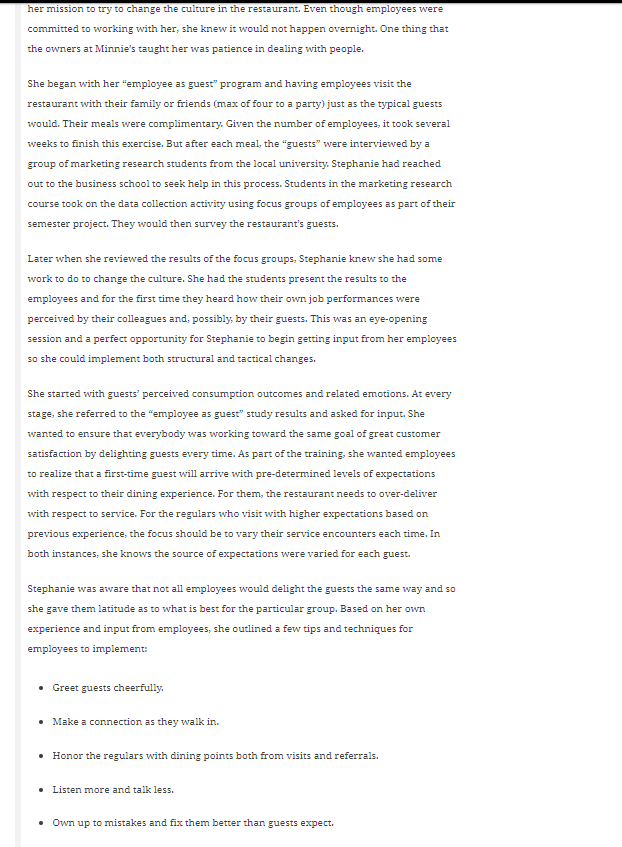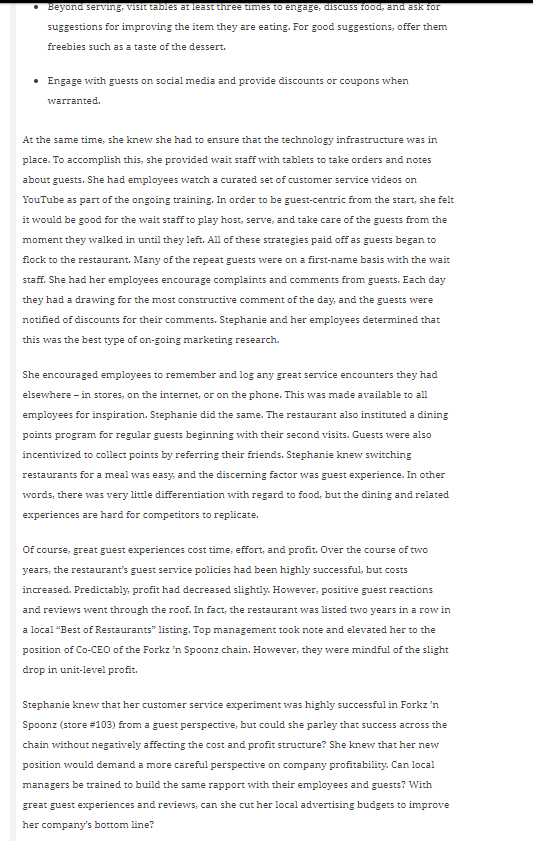Please ASAPP I HAVE ONLY 20 MINUTES PLEASE HELP ME. answer in your own terms ASAPPP PLEASE
SUBJECT: CONSUMER BEHAVIOR DO WITH YOUR OWN TERMS FOLLOW THE INSTRUCTIONS
SOLVE QUESTION PER QUESTION
Read Case and respond the following questions.
A.Which of the theories of post-consumption reaction can be applied to the restaurant experience? Please explain thoroughly.
B.What types of switching costs should the restaurant chain be concerned about? Please explain thoroughly.
C.Given your experiences in restaurants, do you think Stephanie can transfer her guest service experiment to other restaurants within the chain? Why or why not?
D.Which of the characteristics of relationship quality did the FnS (store #103) exhibit in the case? Please explain thoroughly.
E.If guest experience, loyalty and referrals are the keys to FnS success in the long run, can local advertising (on TV, billboards, magazines) be completely eliminated? Why or why not? Please explain thoroughly.
CASE PAGES:



Satisfied Customers: Competitive Asset or Liability? Mohan Menon, University of North Georgia Much has been discussed about customer satisfaction in the service sector. It can make or break the business. But, can it do more? Stephanie is the Co-CEO of Forkz'n Spoonz, a small chain restaurant in the Greenville area with four restaurants that each have their own managers, cooks and wait staff. In her younger days, she managed Minnie's, an independent mom-and-pop restaurant in the small town of Greenville. The owners were a cordial couple that believed in good guest service. The owners believed that good food and excellent customer service were all that was required to be successful in their restaurant business. The town celebrated the owners and patronized Minnie's with amazing loyalty. The local schools held events in the basement, and many a birthday party have been hosted there. During Stephanie's time working at Minnie's, she worked as a wait staff member and later as a manager for several years. She felt that Minne's food was not particularly great, but the owners created a welcome atmosphere for the guests. Her greatest education at Minnie's was learning about guest service. The mantra she learned is not that the 'customer is always right,' but that 'a happy customer is an asset'.' After the owners passed on and the restaurant was closed, Stephanie decided to take her managerial skillset to a bigger city. Along the way, she read books and watched videos on customer service and considered Jeff Bezos, the founder and CEO of Amazon, as an influencer. She once read a quote from him: "We are eager to pioneer and invent. This marries well with customer obsession, because customers are always dissatisfied even if they don't know it, even when they think they are happy. They always want a better way ...." From the moment she read that it made sense to her, and the quote had stuck with her. She has it on her phone's home screen. After moving to the metro area, she applied for a restaurant manager position at Forkz 'n Spoonz (F'nS) among others. During the interview process at the F'nS headquarters, the bosses were impressed by her performance and many of her refreshing ideas. When she got the job as the manager of one of their restaurants, she quickly sought and received approval to implement many of her service policies at her restaurant on a trial basis. From experience, Stephanie knew employees are the key to great service. Train and treat them well, and they will pass on the vibe. While she noticed some of her employees were good at guest service, there was no consistency in the interactions. She had discussions with her employees and explained her basic principles of service, and she sought commitments from them in return for better pay and tip sharing. She then embarked on her mission to try to change the culture in the restaurant. Even though employees were her mission to try to change the culture in the restaurant. Even though employees were committed to working with her, she knew it would not happen overnight. One thing that the owners at Minnie's taught her was patience in dealing with people. She began with her "employee as guest" program and having employees visit the restaurant with their family or friends (max of four to a party) just as the typical guests would. Their meals were complimentary. Given the number of employees, it took several weeks to finish this exercise. But after each meal, the "guests" were interviewed by a group of marketing research students from the local university. Stephanie had reached out to the business school to seek help in this process. Students in the marketing research course took on the data collection activity using focus groups of employees as part of their semester project. They would then survey the restaurant's guests. Later when she reviewed the results of the focus groups, Stephanie knew she had some work to do to change the culture. She had the students present the results to the employees and for the first time they heard how their own job performances were perceived by their colleagues and, possibly, by their guests. This was an eye-opening session and a perfect opportunity for Stephanie to begin getting input from her employees so she could implement both structural and tactical changes. She started with guests' perceived consumption outcomes and related emotions, At every stage, she referred to the "employee as guest" study results and asked for input. She wanted to ensure that everybody was working toward the same goal of great customer satisfaction by delighting guests every time. As part of the training, she wanted employees to realize that a first-time guest will arrive with pre-determined levels of expectations with respect to their dining experience. For them, the restaurant needs to over-deliver with respect to service. For the regulars who visit with higher expectations based on previous experience, the focus should be to vary their service encounters each time. In both instances, she knows the source of expectations were varied for each guest. Stephanie was aware that not all employees would delight the guests the same way and so she gave them latitude as to what is best for the particular group. Based on her own experience and input from employees, she outlined a few tips and techniques for employees to implement: - Greet guests cheerfully. - Make a connection as they walk in. - Honor the regulars with dining points both from visits and referrals. - Listen more and talk less. - Own up to mistakes and fix them better than guests expect. suggestions for improving the item they are eating. For good suggestions, offer them freebies such as a taste of the dessert. - Engage with guests on social media and provide discounts or coupons when warranted. At the same time, she knew she had to ensure that the technology infrastructure was in place. To accomplish this, she provided wait staff with tablets to take orders and notes about guests. She had employees watch a curated set of customer service videos on YouTube as part of the ongoing training. In order to be guest-centric from the start, she felt it would be good for the wait staff to play host, serve, and take care of the guests from the moment they walked in until they left. All of these strategies paid off as guests began to flock to the restaurant. Many of the repeat guests were on a first-name basis with the wait staff. She had her employees encourage complaints and comments from guests. Each day they had a drawing for the most constructive comment of the day, and the guests were notified of discounts for their comments, Stephanie and her employees determined that this was the best type of on-going marketing research. She encouraged employees to remember and log any great service encounters they had elsewhere - in stores, on the internet, or on the phone. This was made available to all employees for inspiration. Stephanie did the same. The restaurant also instituted a dining points program for regular guests beginning with their second visits. Guests were also incentivized to collect points by referring their friends. Stephanie knew switching restaurants for a meal was easy, and the discerning factor was guest experience. In other words, there was very little differentiation with regard to food, but the dining and related experiences are hard for competitors to replicate. Of course, great guest experiences cost time, effort, and profit. Over the course of two years, the restaurant's guest service policies had been highly successful, but costs increased. Predictably, profit had decreased slightly. However, positive guest reactions and reviews went through the roof. In fact, the restaurant was listed two years in a row in a local "Best of Restaurants" listing. Top management took note and elevated her to the position of Co-CEO of the Forkz 'n Spoonz chain. However, they were mindful of the slight drop in unit-level profit. Stephanie knew that her customer service experiment was highly successful in Forkz'n Spoonz (store #103 ) from a guest perspective, but could she parley that success across the chain without negatively affecting the cost and profit structure? She knew that her new position would demand a more careful perspective on company profitability. Can local managers be trained to build the same rapport with their employees and guests? With great guest experiences and reviews, can she cut her local advertising budgets to improve her company's bottom line









